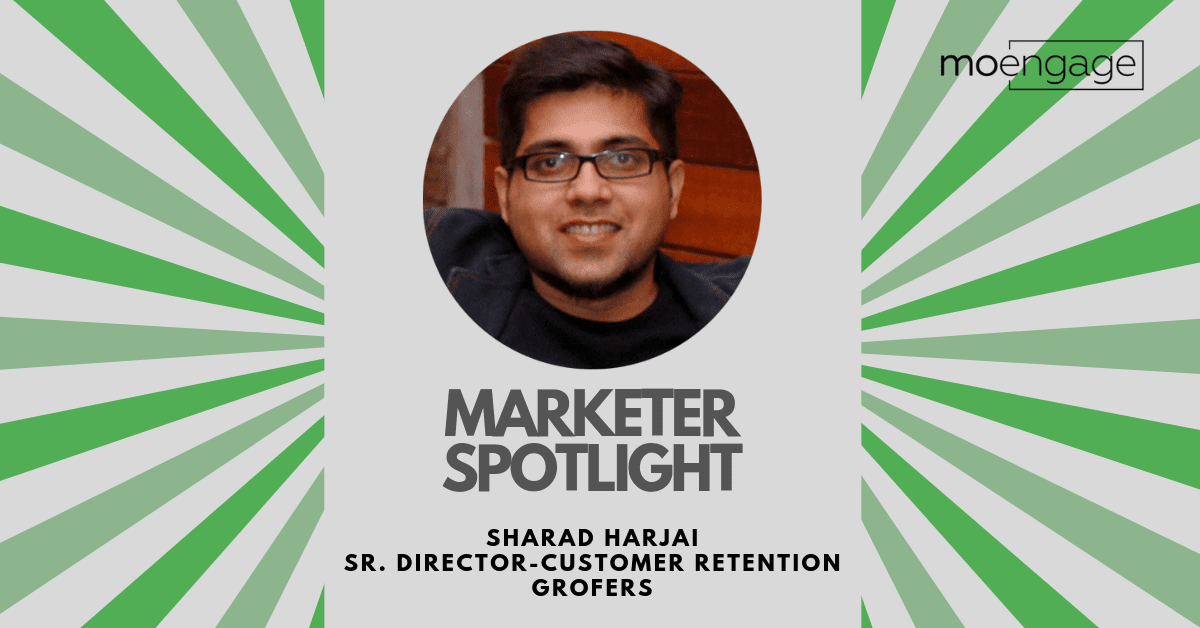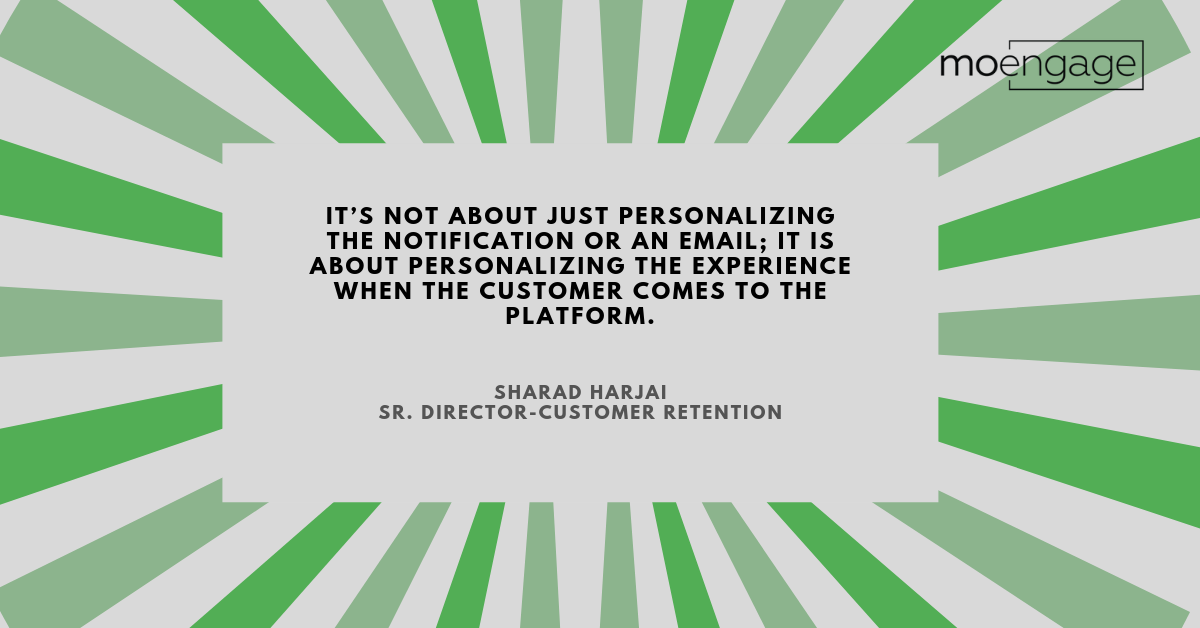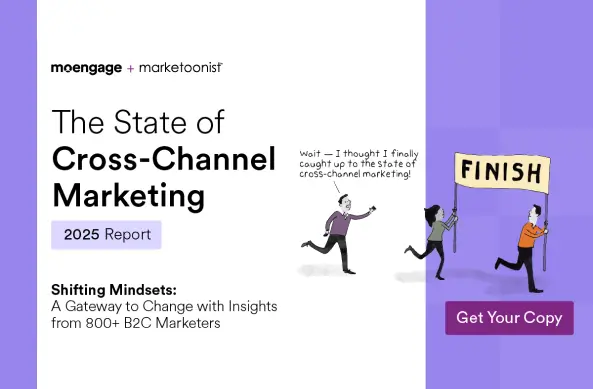Decoding Hyper-personalization in Retail Marketing with Sharad Harjai

Reading Time: 8 minutes
Bonus Content
|
Editor’s note: In our latest Marketer Spotlight edition, Sharad Harjai, the senior director of revenue and customer retention of Grofers; gives us his opinion on buzzwords such as personalization and AI, and tells us how personalization has helped Grofers to improve the customer experience across various touchpoints.
Marketer Spotlight series covers opinions and advice from marketing leaders and influencers on the industry challenges, trends, and best practices.
Welcome to Marketer Spotlight, Sharad. Tell us about yourself, your company, and your experience with marketing.
Sharad: I have an overall experience of about 10 years. I come from an IT background. I was an engineer for over five a half years. However, I wanted to do more and work with smaller organizations, to contribute much more to the growth of the company. So, right after my MBA, I joined Grofers. I was asked to set up the marketing function. I got my hands dirty by doing the most essential things on the ground. Grofers is a great place to work and is close to my heart because of the opportunity I got to learn from them.
You have been part of the growth story at Grofers right from a startup to India’s leading online grocery store. Along this journey, what were your priorities from a marketer’s perspective?
With each phase of growth, our focus areas have also evolved. It is very different from what it was in six months and what it was in the last four years. Four years ago, it was about setting a basic structure. We started with a few metrics. The first entire year was to focus and do anything and everything to know what works for us. However, along the way, we learned from the insights we gathered from the market. At the most basic level, we were focused on setting up the market. We had the right set of people who had the technical knowledge and the eagerness to learn.
Now, we are more focused on setting up a mature process and a cross-functional team. As we mature, we are now more focused on making Grofers a reputed brand in the grocery segment. I believe in the last two years, we have matured a lot. The team has done a great job in helping us establish the brand.
While your organization and teams have evolved, is there any change you see in the consumers in these four years?
Absolutely, we have seen a shift because of multiple reasons. One of the reasons being that the ecosystem has evolved. There is a shift in digital services, different business models, the way consumers shop and buy. Any new business model that comes into the market, not just groceries, helps the ecosystem to grow and the customer behavior also evolves in a positive direction. So I think in the last four years we have seen consumer behavior evolve.
Do you think personalization is required? Do consumers appreciate it?
I don’t think a consumer wakes up saying, “Yes, someone is sending me a personalized communication.” However, unconsciously they respond better to personalized communication than to a non-personalized message.

Could you share some examples of personalized campaigns that your teams have implemented in the past and what kind of results did you see?
Personalization is not a step A, B, C process and there are various ways to personalize the overall experience of the customer. For us, it’s not about just personalizing the notification or an email; it is about personalizing the experience when the customer comes to the platform. When a person comes to our platform, we understand her behavior and show her the products that she might be interested to buy and add to the cart. When a delivery boy goes to the customer’s house and says, “Ma’am, this is something you purchased, and this is the benefit you get,” that’s also a part of personalization. We have done multiple things across various touchpoints. From how we talk to people, what we talk to people, and how we respond to them when they have a complaint is personalized.
| Learn how creating the right segments is critical to personalization in this blog. |
Which metrics of your business has personalization improved? Does it boost loyalty, sales, or engagement?
We use personalization to build the trust of the consumer. That’s not a metric that can be measured, but personalization helps you do a much better job in how you communicate, how to improve the entire experience of the customer. This makes the customer comfortable with the brand.
What are the steps that you take to ensure that the experience for the customer remains consistent across online and offline touchpoints?
The way you approach personalization is different for different businesses, and each touchpoint has to be personalized differently. So, the way we approach personalization to manage our SMS will be different from the delivery touchpoint. Every channel that we use to communicate with the consumer is looked at differently and the experience created out of it is also different. So, how I change the strategy of CRM channels will be very different from how I will make the app personalized. The basic framework remains the same – that you understand the consumer as much as you can and that touchpoint should be able to establish trust in a better way.
Listen to Sharad share insights on building customer loyalty in this video:
How do you unify interactions at multiple touchpoints to build a broader picture of your consumers?
We understand the consumer’s behavior from an intentional point or an unintentional point of view. So, if a customer shops in a particular way on our platform, it tells us about his behavior, which is linked to some metric or the other. If a consumer gives us feedback about a product we are selling, it gets tied to a metric about that product’s quality. If there is a particular way in which the customer shops on our platform, it tells me a lot about the behavior of the customer. We map these moments that customers show to us with one particular metric which we need to improve upon.
So, if customers report an issue about a product or write an email about it, we tie it to the broad metric of product quality and know what we have to improve upon. We also have a full-fledged team that reaches out to the customers to understand their pain points and to know what they have to say about the service.
Mom and pop stores have been in existence for a long time and offer the highest level of personalized shopping experience. How easy or difficult is it to replicate that experience in the digital world?
The experience that a person gets in an offline store can be replicated in the digital world. Like the example you gave, we can replicate the same thing on our platform. If a customer is buying something repeatedly, we start showing relevant options to the customers when they open the app. However, some elements cannot be replicated. We try to show it to them in a different way altogether.
For example, when you go to a store, the store manager greets you and does not ask you too many questions that will hamper your experience. The digital world has its own version to do that. When a consumer places an order, we do not contact him multiple times to complete the end process. We try to replicate what we learn from the offline world into our platform.
Why do you think companies fail to implement personalization? What are the key factors or the rules that they’re missing?
I think the primary reason is that there is not enough focus on personalization. Companies need to build a focus on it. The second reason is, many companies feel it is too advanced to build and deliver to a consumer. However, this should not be a reason not to offer a personalized experience to the customer. Companies have to evolve and move past the era of feeling personalization is not essential.

When you meet your friends and talk to them about how brands have abused different channels, we realize that while we have connected the entire ecosystem, we have not done a great job at making things personalized for the consumers. We continue blasting messages thinking it is still relevant to him or her. We need to do a much better job at that.
How do you build a loyalty program or a loyalty strategy? Do you think personalization plays a role there too?
It definitely does but in a slightly different way. It should be defined enough so that it caters to the customer who comes onboard. That’s the thought we should create while designing a loyalty program instead of creating too many variants to it. Personalization is a part that goes into the designing part of loyalty.
When you send a tailored marketing communication, do you visualize experiences for your customers based on broad segments or is it different for each user?
There are various ways to create buckets. I think every business has its own nuances on how to create buckets for its consumers where one bucket crisply defines what other sets of buckets are and at a broad level behave in a similar way. We do that. We also create different experiences. So, the experience of the customer who is coming for the first will be very different from the customer who is coming for the 20th time. We need to do a couple of things to ensure that the customer placing his first order understands the brand in a better way. A customer who is placing the 20th order does not require the same explanation. So, the way I personalize something for him will be different from the one who has come for the first time.
What is your advice to marketers when they do personalization?
Try to understand the customer as much as you can from a qualitative and quantitative perspective. We have a dedicated team that delivers us consumer insights. The marketing team goes out and meets people in person to understand the overall behavior of the consumer in a better way. That’s a core focus area for us. Because, at the end of the day, creating segments is a no-brainer job. However, you can create the right segment only when you understand the consumer well.

What according to you is the role of AI in personalization? Has AI been beneficial for you at Grofers?
One of the problems that we all face (and it’s not about marketers) is the moment we start running test at a scale, we are unable to tie things together. I think AI services and tools help us to test in a much better way. However, I don’t think the tools and the framework that we have in the market right now are extremely smart to deliver exponential higher efficiency. But it’s the direction we should move towards.
Which is your personal favorite brand and why?
There are many. Paper Boat, for example, has created a great experience for its product. With a very simple brand positioning, they managed to invoke your own memories in your head instead of sending the same message all across. Similarly, smaller brands such as Amoeba have done a great job. These small brands have created experiences in the right way and have managed to establish a great connection with the customers, which I appreciate.
Thank you, Sharad, for taking out time to share your opinion on personalization and segmentation. Forming an emotional connect and connecting consistently with your audience with the same emotion is an excellent way to build customer experience.
Marketers – Is there someone you’d like us to feature in our spotlight series? What topics would you recommend for our next feature? We invite your recommendations and feedback via the comments section below.







